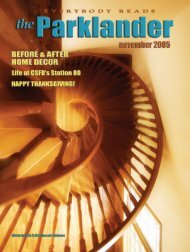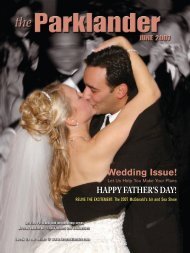February 2008 - The Parklander Magazine
February 2008 - The Parklander Magazine
February 2008 - The Parklander Magazine
- No tags were found...
Create successful ePaper yourself
Turn your PDF publications into a flip-book with our unique Google optimized e-Paper software.
OUTDOORSDeer AntlerTreasure Huntingby Robert LoewendickFor most outdoors enthusiasts, their huntingand fishing pursuits follow a normal routineof seasons. A new “season” of sorts isbecoming popular and is finding its way ontothe schedule. It is hunting for the naturallyshed antlers of the white-tailed deer. Latewinter and early spring offers the outdoorsperson the season to hike through thewhitetail’s habitat in search of a shed antler.Doing so provides information about the specificherd and is another entertaining reason to get outside.<strong>The</strong> shedding of antlers is an annual event for the white-taileddeer. <strong>The</strong> antler growing cycle begins in the spring, carriesthrough the summer and concludes with shedding in the winteror early spring. At the conclusion of the fall breeding season, thebuck’s need for his antlers is complete. <strong>The</strong> antlers are used forfighting other bucks for the attention of females and otheruses, as marking his territory on trees and shrubs, all for the sakeof reproduction.Antler treasure hunting while enjoying a hike with the family orfriends is the perfect experience for an early spring outing.Although an antler may not be a million bucks (just the head gearof one buck) type of treasure, searching for a shed antler offers achange of pace, different scenery, great exercise, and anotheropportunity to include children in the natural world.Sheds are found in all types of the deer habitat including bedding,feeding and watering areas.Think about the most likely event whena loose antler will become unattached. Swift head movements occurmore often during travel. A location to check first is where trailsintersect streams and brush, any situation that a buck would meetcausing him to jump.<strong>The</strong> landing from a jump will jolt the antler torelease. Feeding areas are the next best location, again because ofhead movement. Head down feeding and then a sudden jerkupward to check for danger will send a loose antler to the ground.So what can you do with your new found treasure? Mostcollectors mount their antlers on a wood plaque for display. Mykids like to show them off frequently, so they simply lay theirs on ashelf where they can have easy access to them. Antlers make a niceshow and tell item for youngsters at school also. Manycrafts people use the antlers for knife handles, belt buckles, andjewelry, as well as many other items.When children participate in shed hunting, remember a shedantler treasure is not the only one to be found. Once searchingbegins, don’t rush your young search team. <strong>The</strong>y will discovermany other interesting finds. Let them explore. <strong>The</strong> more theybecome interested in exploring theoutdoors, chances are they will carryon their excitement for nature andkeep the memories of theiradventures with them throughouttheir lives. Hopefully they willpersuade others to get out and enjoyas well. It’s more important nowthan ever to teach our children topreserve our natural environmentsand to carry on good managementpractices of them.Robert Loewendick is anaward-winning freelanceoutdoor/sports writer. E-mail himat loewendick@theparklander.com.White-tailed deer shed their antlers in latewinter to early spring. Searching for thesedropped treasures are fun for all ages ofoutdoors enthusiasts.60 FEBRUARY <strong>2008</strong>
















